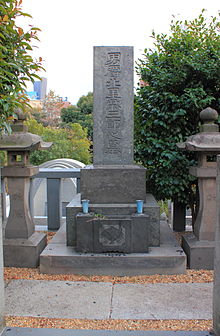Kitasato Shibasaburō
Kitasato Shibasaburō ( Japanese 北 里 柴三郎 ; born January 29, 1853 in Oguni , Aso-gun , Higo Province (today: Kumamoto Prefecture ); † June 13, 1931 in Tokyo ) was a Japanese bacteriologist .
Life
Kitasato was born towards the end of the Edo period in a small village as the eldest son of the village chief Korenobu Kitasato. In his youth he initially had a military career in mind, but then went to the Kumamoto Medical School in 1872 on the advice of his parents after completing the Jishūkan School ( 時 習 館 ) of the Kumamoto domain . Here he met the Dutch military doctor Constant George van Mansvelt, who had been invited as a Western specialist to take care of the modernization of medical training. Mansvelt encouraged the young Kitasato to the best of his ability and recommended further training in Tokyo and later in Europe when he left.
In 1875 Kitasato began studying at the Tokyo Medical School (Tōkyō igakkō, 東京 医 学校 , from 1877 Medical Faculty of the Imperial University of Tokyo ), from which he graduated in 1883 with a doctorate in Igakushi. He then went first to the Health Department of the Ministry of the Interior, headed by Nagano Sensai, where he worked as a research assistant at Ogata Masanori ( 緒 方正 則 , 1853-1919). Ogata had recently returned from Germany and set up the first Japanese laboratory for bacteriology.
On the advice and with the support of Ogata, Kitasato went to Berlin in 1885 , where he worked together with Emil von Behring in Robert Koch's laboratory. There he examined the causative agents of tetanus ( tetanus ) and diphtheria . In 1889 he was the first to succeed in growing Clostridium tetani , the tetanus-causing bacterium, in a pure culture . In 1890, together with Emil von Behring, he demonstrated the effectiveness of antitoxins against tetanus and diphtheria ( diphtheria antitoxin ). Kitasato returned to Japan in 1892.
In 1894, at the same time as Alexandre Yersin , Kitasato was researching the pathogen that caused the plague epidemic in Hong Kong . The description of the pathogen published by him later turned out to be an error, which can probably be traced back to the contamination of bacterial cultures by pneumococci. For some time Kitasato was considered to be the discoverer of the plague pathogen, which is now called Yersinia pestis after Yersin .
In 1897 he and his student Kiyoshi Shiga found the pathogen causing dysentery , which was named after him Shigella dysenteriae .
In 1914 the Institute for Infectious Diseases was integrated into the University of Tokyo. He resigned in protest and founded the Kitasato Research Institute in Tokyo in 1915, which is still preserved today as part of the Meiji Mura open-air museum in Inuyama . From this the private Kitasato University developed .
In 1921 he and others founded the Terumo company , the name of which is derived from the German word “ thermometer ”. The first reliable clinical thermometer was developed by Kitasato.
In 1917 he became dean of the medical faculty at Keiō University and in 1923 the first president of the Japanese Medical Association. For his achievements he was raised to the nobility in 1924 . He received the title of Danshaku (baron) in the Japanese nobility system. In 1927 he was elected a member of the Leopoldina . Since 1914 he was a member of the American Philosophical Society .
He died of a cerebral hemorrhage in his Tokyo home in 1931. His grave is in the Aoyama Cemetery .
literature
- Michael Hubenstorf: Kitasato Shibasaburō , in: Wolfgang U. Eckart and Christoph Gradmann : Doctors Lexicon. From antiquity to the present , 3rd edition, Springer, Berlin and Heidelberg 2006, pp. 191 + 192, ISBN 978-3-540-29584-6 (print), ISBN 978-3-540-29585-3 (online ).
- Werner Köhler : Kitasato, Shibasaburo. In: Werner E. Gerabek , Bernhard D. Haage, Gundolf Keil , Wolfgang Wegner (eds.): Enzyklopädie Medizingeschichte. De Gruyter, Berlin / New York 2005, ISBN 3-11-015714-4 , p. 753 f.
Remarks
- ↑ In Japanese sources mostly correct " き た ざ と し ば さ ぶ ろ う " = Kitazato Shibasaburō.
- ↑ Member History: Shibasaburo Kitasato. American Philosophical Society, accessed October 25, 2018 .
| personal data | |
|---|---|
| SURNAME | Kitasato, Shibasaburō |
| ALTERNATIVE NAMES | 北 里 柴三郎 (Japanese) |
| BRIEF DESCRIPTION | Japanese bacteriologist |
| DATE OF BIRTH | January 29, 1853 |
| PLACE OF BIRTH | Oguni , Aso-gun , Higo Province (now: Kumamoto Prefecture ) |
| DATE OF DEATH | June 13, 1931 |
| Place of death | Tokyo |


